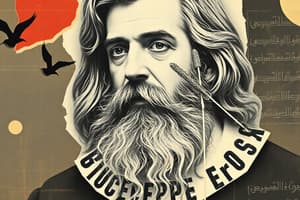Podcast
Questions and Answers
What does bel canto mean?
What does bel canto mean?
- Beautiful performance
- Beautiful singing or beautiful song (correct)
- Beautiful singing
- Beautiful song
When was the term bel canto associated with a 'school' of singing?
When was the term bel canto associated with a 'school' of singing?
- In the early 19th century
- In the late 19th century
- In the middle of the 19th century (correct)
- Before the 19th century
What were the main features of the bel canto style?
What were the main features of the bel canto style?
- Both A and B (correct)
- Legato phrasing and skill in executing highly florid passages
- None of the above
- Beauty of sound and brilliance of performance
Which Italian composers wrote bravura works for the stage during the 'bel canto era'?
Which Italian composers wrote bravura works for the stage during the 'bel canto era'?
What was one reason for the decline of the bel canto style in Italy?
What was one reason for the decline of the bel canto style in Italy?
When was the phrase 'bel canto revival' coined?
When was the phrase 'bel canto revival' coined?
What is the bel canto technique?
What is the bel canto technique?
Who was the most prominent bel canto pedagogue of the 19th century?
Who was the most prominent bel canto pedagogue of the 19th century?
Who are some historically and artistically significant 19th-century singers who exemplify bel canto ideals?
Who are some historically and artistically significant 19th-century singers who exemplify bel canto ideals?
Flashcards are hidden until you start studying
Study Notes
Bel Canto: A Term with Multiple Meanings
-
Bel canto is an Italian term that means "beautiful singing" or "beautiful song" and is used to refer to Italian singing.
-
The term was not associated with a "school" of singing until the middle of the 19th century, when writers used it nostalgically to describe a manner of singing that had begun to wane around 1830.
-
Bel canto refers to the Italian-originated vocal style that prevailed throughout most of Europe during the 18th and early 19th centuries.
-
The main features of the bel canto style were beauty of sound, brilliance of performance, legato phrasing, and skill in executing highly florid passages.
-
The term bel canto is sometimes attached to Italian operas written by Vincenzo Bellini and Gaetano Donizetti, who wrote bravura works for the stage during the "bel canto era."
-
The popularity of the bel canto style as espoused by Rossini, Donizetti, and Bellini faded in Italy during the mid-19th century and was overtaken by a heavier, less embroidered approach to singing necessary to perform the innovative works of Giuseppe Verdi.
-
One reason for the eclipse of the old Italian singing model was the growing influence within the music world of bel canto's detractors, who considered it to be outmoded and condemned it as vocalization devoid of content.
-
In the late 19th century and early 20th century, the term "bel canto" was resurrected by singing teachers in Italy, who invoked it against an unprecedentedly vehement and vibrato-laden style of vocalism.
-
In the 1950s, the phrase "bel canto revival" was coined to refer to a renewed interest in the operas of Donizetti, Rossini, and Bellini.
-
Today, some of the world's most frequently performed operas, such as Rossini's The Barber of Seville and Donizetti's Lucia di Lammermoor, are from the bel canto era.
-
Musicologists occasionally apply the label "bel canto technique" to the arsenal of virtuosic vocal accomplishments and concepts imparted by singing teachers to their students during the late 18th century and the early 19th century.
-
Bel canto-era teachers were great believers in the benefits of vocalise and solfeggio.
-
Major refinements occurred to the existing system of voice classification during the 19th century as the international operatic repertoire diversified, split into distinctive nationalist schools, and expanded in size.Bel Canto and its Influence on Singing in the 19th Century
-
New categories of singers emerged in the 19th century, including mezzo-soprano and Wagnerian bass-baritone, as well as sub-categories such as lyric coloratura soprano, dramatic soprano, and spinto soprano.
-
Singing teachers in the 19th century did not have uniform teaching methods, but all adhered to the same bel canto principles.
-
Manuel García was the most prominent bel canto pedagogue of the 19th century, and his sister Pauline Viardot was also an important teacher of voice.
-
The former students of bel canto teachers can be heard on acoustic recordings made in the early 20th century.
-
Sir Charles Santley, Gustav Walter, Adelina Patti, and Marianne Brandt are examples of historically and artistically significant 19th-century singers who exemplify bel canto ideals.
Studying That Suits You
Use AI to generate personalized quizzes and flashcards to suit your learning preferences.




